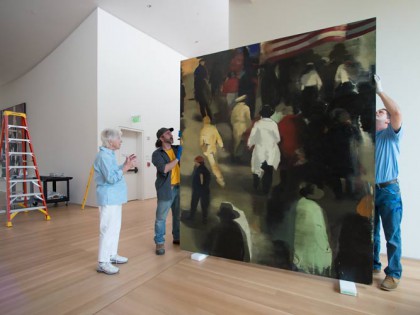During its recent meeting, the university’s Board of Trustees visited the new Anderson Collection at Stanford University, gave preliminary approval to two new campus buildings and gave final approval to three construction projects, including new residences for undergraduates and for first-year students at the Graduate School of Business.
At its recent meeting, the Stanford University Board of Trustees took an early evening stroll among the modern and contemporary American paintings and sculptures in the new Anderson Collection at Stanford University.
Their visit followed an in-depth presentation by Alexander Nemerov, a Stanford scholar of American art, on Jackson Pollock’s Lucifer, one of its most important works, and a talk by Jason Linetzky, the inaugural director of the Anderson Collection at Stanford University, on the history of the collection, which includes more than 100 works of art.
During the Oct. 6-7 meeting, trustees held a celebratory dinner to honor and personally thank the family that donated the collection to the university – Harry W. and Mary Margaret Anderson, and their daughter, Mary Patricia Anderson Pence.
The Andersons, who mingled with trustees at the museum, also joined trustees for the presentation by Nemerov, the Carl and Marilynn Thoma Provostial Professor in the Arts and Humanities at Stanford.
Steven A. Denning, chair of the board, said the Anderson family’s “extraordinary, unprecedented gift will elevate the visual arts at Stanford and transform the university in unimaginable ways.”
The Anderson Collection, which opened in September, is the newest addition to the university’s arts district, joining Bing Concert Hall, Cantor Arts Center and Frost Amphitheater. Next year, theMcMurtry Building for the Department of Art and Art History will become part of the arts neighborhood.
“We’re seeing the arts district at Stanford come to life and become a reality,” Denning said.
Trustees also heard a presentation on Heads Up, the safety campaign Stanford recently launched to inform the campus community of construction activity and to provide strategies for navigating safely – whether on foot or on wheels.
“There is so much construction going on all over campus, including the McMurtry Building, the Manzanita and Lagunita Court residence halls, and the Roble underground garage,” Denning said. “The Heads Up campaign encourages everyone to look up and take one extra step to stay safe when they’re traveling around campus, so we don’t have any accidents.”
Trustees approve construction projects
Denning said trustees gave concept and site approval – the first step in the approval process – to two buildings. They gave construction approval – the last step – to three projects, including housing for undergraduates and business school students.
Trustees gave concept and site approval for a new building to house two emerging interdisciplinary research institutes:
- Stanford ChEM-H (Chemistry, Engineering & Medicine for Human Health), which brings together chemists, engineers, biologists and clinicians to understand life at a chemical level and apply that knowledge to improving human health. The institute builds on Stanford’s extraordinary talent in the schools of Humanities and Sciences, Engineering and Medicine, as well as its proximity to SLAC National Accelerator Laboratory, to explore this new frontier at the interface of chemistry and human biology.
- Stanford Neurosciences Institute, which is focused on understanding how the brain gives rise to mental life and behavior. Its interdisciplinary community of scholars come from many disciplines, including neuroscience, medicine, education, law and business.
The $252.6 million project will provide the two intellectual communities with facilities designed to foster great ideas and innovative scholarship, including wet, dry and computational laboratory space, offices for faculty, postdoctoral scholars and students, and collaborative common spaces for formal and informal teaching and learning.
The building will be located on the west side of campus on the site currently occupied by the Cardinal Cogeneration Plant Facility. (Stanford is building a new Central Energy Facility to replace the cogeneration plant as part of its Stanford Energy System Innovations project.)
The location of the building will facilitate easier and more frequent collaboration within a single physical space among the faculties of the schools of Medicine, Engineering, and Humanities and Sciences.
The new building is scheduled to return to the Board of Trustees for design approval in April 2015 and construction approval in April 2016. The building is expected to be completed in December 2017.
Trustees also gave concept and site approval for a new building for conferences and offices for theHoover Institution, a public policy research center at Stanford devoted to the advanced study of politics, economics and political economy.
The new building will provide more space for Hoover, which has outgrown its facilities for conferences, symposia and donor retreats.
Hoover’s new building will be located on the site now occupied by the Cummings Art Building along Lasuen Mall. (Cummings is the home of the Department of Art and Art History, which will be moving into the new McMurtry Building next year.)
The $62.7 million Hoover project is expected to return to trustees for design approval in February 2015 and for construction approval in June 2015. The building is expected to be completed in the spring of 2017.
The Board of Trustees gave construction approval to three projects: a new residence hall for first-year students at the Graduate School of Business; two new dormitories at Lagunita Court, an undergraduate residence on Santa Teresa Street; and a new field house for the football team at Stanford Stadium.







